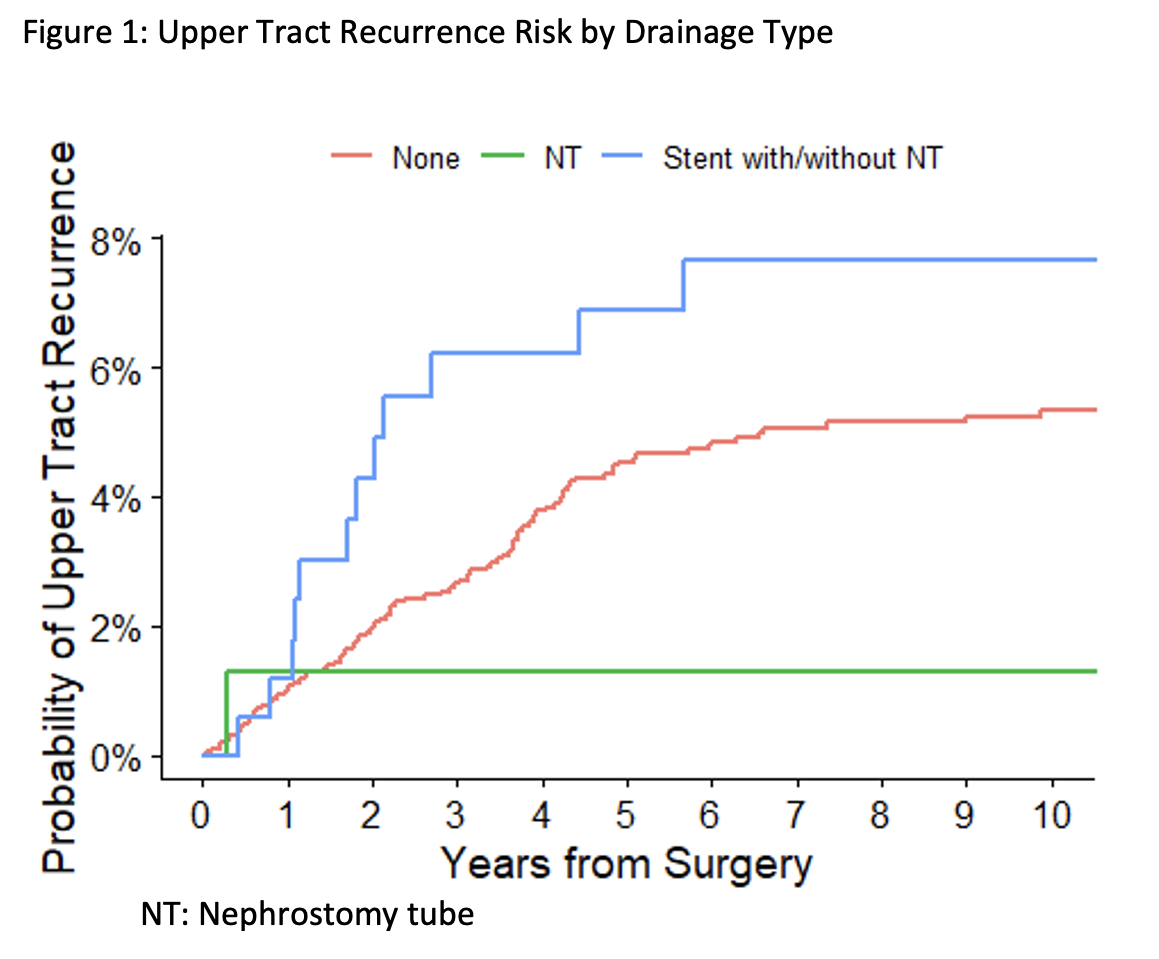Back
Poster, Podium & Video Sessions
Moderated Poster
MP56: Bladder Cancer: Invasive V
MP56-12: Upper Tract Recurrence Risk based on Drainage Method for Ureteral Obstruction prior to Radical Cystectomy
Monday, May 16, 2022
10:30 AM – 11:45 AM
Location: Room 228
Wesley Yip*, Daniel Sjoberg, Nathan Wong, Manuel de Jesus Escano, Song Jiang, Carissa Chu, Nicole Benfante, Sherri Donat, Harry Herr, Guido Dalbagni, Bernard Bochner, Eugene Cha, New York, NY

Wesley Yip, MD
Memorial Sloan Kettering Cancer Center
Poster Presenter(s)
Introduction: Ureteral obstruction by bladder tumors can cause hydronephrosis with the potential for renal dysfunction. Renal drainage can be achieved by either ureteral stent placement or percutaneous nephrostomy tube, but there is a potential risk for upper tract seeding by retrograde manipulation during stent placement and reflux of urine. We aim to determine if retrograde ureteral stent placement prior to radical cystectomy (RC) increases the risk of upper tract recurrence.
Methods: 2475 patients who underwent RC at our institution from January 2000 to June 2016 were included in our analysis. Patients were categorized by: no drainage, nephrostomy tube only, or stent with or without nephrostomy tube. Fine-Gray competing risks regression analysis was used to assess whether ureteral stent placement increased the risk of upper tract recurrence, with recurrence to another region and death from other causes as the competing events. Univariable and multivariable models were then created, with the latter adjusted for pathologic T stage, carcinoma in situ (CIS) in the RC specimen, and prior intravesical therapy.
Results: Of 2475 patients who underwent RC, 111 upper tract recurrences were observed with a median follow-up of 6.0 years (IQR 2.5, 9.3) among those without an event. 2203 (89%) patients had no drainage, 88 (3.6%) had a nephrostomy tube only, and 184 (7.4%) had a ureteral stent with or without nephrostomy tube. There were 98 upper tract recurrences in the no drainage group, only 1 in the nephrostomy tube group, and 12 in the ureteral stent group. The probability of upper tract recurrence based on drainage method is displayed in Figure 1. On multivariable analysis, ureteral stent placement was associated with an increased risk of upper tract recurrence (HR 2.32; 95% CI 1.27, 4.22).
Conclusions: Ureteral stent placement for ureteral obstruction prior to radical cystectomy is associated with an increased risk of upper tract recurrence compared to nephrostomy tube placement, although patient selection factors not accounted for in our analyses may be present. This should be considered when weighing the risks and benefits of ureteral stent versus nephrostomy tube placement in these patients.
Source of Funding: Ruth L. Kirschstein National Research Service Award T32CA082088

Methods: 2475 patients who underwent RC at our institution from January 2000 to June 2016 were included in our analysis. Patients were categorized by: no drainage, nephrostomy tube only, or stent with or without nephrostomy tube. Fine-Gray competing risks regression analysis was used to assess whether ureteral stent placement increased the risk of upper tract recurrence, with recurrence to another region and death from other causes as the competing events. Univariable and multivariable models were then created, with the latter adjusted for pathologic T stage, carcinoma in situ (CIS) in the RC specimen, and prior intravesical therapy.
Results: Of 2475 patients who underwent RC, 111 upper tract recurrences were observed with a median follow-up of 6.0 years (IQR 2.5, 9.3) among those without an event. 2203 (89%) patients had no drainage, 88 (3.6%) had a nephrostomy tube only, and 184 (7.4%) had a ureteral stent with or without nephrostomy tube. There were 98 upper tract recurrences in the no drainage group, only 1 in the nephrostomy tube group, and 12 in the ureteral stent group. The probability of upper tract recurrence based on drainage method is displayed in Figure 1. On multivariable analysis, ureteral stent placement was associated with an increased risk of upper tract recurrence (HR 2.32; 95% CI 1.27, 4.22).
Conclusions: Ureteral stent placement for ureteral obstruction prior to radical cystectomy is associated with an increased risk of upper tract recurrence compared to nephrostomy tube placement, although patient selection factors not accounted for in our analyses may be present. This should be considered when weighing the risks and benefits of ureteral stent versus nephrostomy tube placement in these patients.
Source of Funding: Ruth L. Kirschstein National Research Service Award T32CA082088


.jpg)
.jpg)